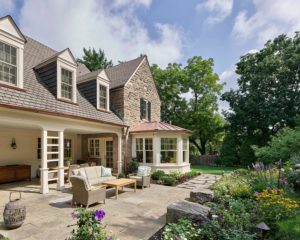What will my addition/renovation cost and would it be worthwhile from an investment standpoint?
Of course, there are intangible benefits to undertaking a renovation or addition project, such as more daylight, better flow, more space for family gatherings, views to the outside, and so on. We can’t place a dollar value on those. But let’s look at this question from a dollars-and-cents viewpoint, via two examples of renovation cost and return on investment.
Dave and Christie live in a starter home and would like to add a family room now that they are expecting their second child. Plus, the kitchen isn’t as functional as they wish and offers no view of the backyard where their 5-year-old likes to play. Not only do they have a firm budget cap in mind, they also want to avoid overspending and get priced out of the market when they are ready to move into a larger home. How we answer their question depends on how Dave and Christie answer this one:
What’s your timeline?
 Across town, Ben and Olivia have a stone colonial they love. It’s not just the house — they love the yard, the garden, even the garage. But their kitchen and bathrooms were outdated. They were also interested in making their home more energy efficient. They don’t have children and they do have funds. What’s more, they want to live in the house forever. Though they wanted to establish a budget, over-improvement was never an issue for them. Speaking with us about their plans and timeline, they decided, “Yes, let’s go ahead with all our renovations.” We helped them do exactly that.
Across town, Ben and Olivia have a stone colonial they love. It’s not just the house — they love the yard, the garden, even the garage. But their kitchen and bathrooms were outdated. They were also interested in making their home more energy efficient. They don’t have children and they do have funds. What’s more, they want to live in the house forever. Though they wanted to establish a budget, over-improvement was never an issue for them. Speaking with us about their plans and timeline, they decided, “Yes, let’s go ahead with all our renovations.” We helped them do exactly that.
But most people have a more limited budget and hope to get a return, or at least a break-even, on the investment in their homes. If you plan to live in the house for six to ten more years, then a rule of thumb is, yes, it probably is worth doing most of the renovations you have in mind, but you’ll need to gain clarity about your construction costs so you don’t overspend. These costs depend on several factors and we’ll get to those in a minute. The bottom line is: If the proposed scope exceeds the predicted increase in appreciation, then you may want to drop the “nice to haves” until you are in more of a financial comfort zone.
If, on the other hand, you plan to live in the house for less than five years, then we generally find that only limited renovations, with an eye toward selling the house, are optimal. No one can accurately predict the rate of appreciation of residential real estate (remember the housing crash of 2008!), but most experts tend to agree on 3% to 5% per year. For those with a short timeline, a project that adds more than one-quarter to the current resale value probably isn’t worth doing.
As for Dave and Christie, they expect to outgrow their two-bedroom house in about five years. They gained clarity with us around construction costs and what would be required in the way of a zoning variance if they were to add the family room. Prepared now to make a confident decision, Dave and Christie decided to update the kitchen and add the window to the backyard, but not do a family room addition. This will give them the highest return on design financially and emotionally, so that they are able to enjoy their home in the present with financial peace of mind for the future.
Get construction cost clarity
We recommend going through a process to gain that needed clarity early on in your process:
- Timeline – Predict how long you expect to remain in your home following completion of your proposed project.
- Project scope — Create a list of items that you want to fix or change. The project scope basically summarizes what you want to do.
- Zoning requirements — You’ll need to have your architect review zoning to determine whether a variance will be needed. The answers impact both schedule and cost.
- If there is an addition (any increase in volume of house), get an analysis of the stormwater management regulations as well.
- If your home is in a historic district, have your architect review the related regulations.
- High level construction cost budget for each part of the project — This would be prepared by the architect, possibly in consultation with a builder.
- Compare the cost of your project with other homes for sale – consult with a realtor about how much value the proposed project might add and review other listings.
- Consult with your architect to review the above — What makes sense? We help our clients determine how much they are improving relative to the neighborhood and identify options for scaling back or proceeding as planned.
Both couples got the answers they needed through this process. Though they arrived at different outcomes, they are enjoying their renovated homes and feel good about their decision.
Searching the web can provide some idea of current construction costs for renovation projects. For specific answers to questions about embarking on a major renovation, addition, or new home, we offer a consultation service we call the Clarity Report. Learn more here: kriegerarchitects.com/residential-projects/project-consultation-services/